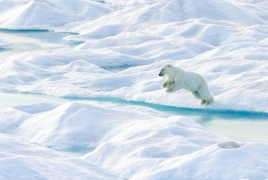
Hundreds of people have undergone intense preparation for an expedition designed to figure out what a warming Arctic means for us all, National Geographic says.
They will face some of the harshest conditions on Earth: polar night, complete darkness, heavy storms, and temperatures that can reach almost minus 50 degrees Fahrenheit.
That’s why Markus Rex, the atmospheric scientist leading a 600-person-strong Arctic expedition— the largest ever—has thought of everything that could go wrong.
“We have plans for all events, even possible loss of the vessel,” he says, though he doesn’t think that’s likely.
Named MOSAiC (Multidisciplinary drifting Observatory for the Study of Arctic Climate), the $150-million-dollar expedition will last for a full year and involve people from 19 different countries.
It will be the largest and longest Arctic expedition in history and the first major Arctic expedition in a region that climate change is warming faster than anywhere else on Earth.
Leaving from Tromsø, Norway on September 20, the ship will position itself in the transpolar drift stream and float, trapped in ice for a year, to northern Greenland. The expedition will mostly take place on a German ice breaker called the Polarstern, but four additional ice breakers supplied by Sweden, Russia, and China will periodically deliver people and supplies.
Those participating in the leg that takes place over polar night will have to carefully conduct their research. The ecologists studying phytoplankton and algae will only use red lamps (white light could disrupt their seasonal patterns). Guards must wear night vision goggles to scout for polar bears. And days will be highly structured to ensure everyone aboard the ship maintains their circadian rhythms.

